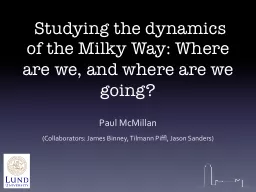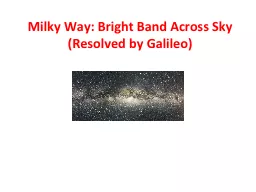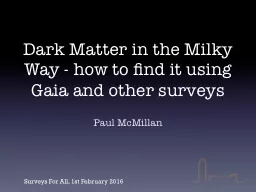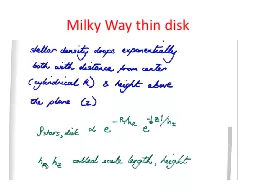PPT-Studying the dynamics of the Milky Way: Where are we, and
Author : jane-oiler | Published Date : 2017-11-03
Paul McMillan Collaborators James Binney Tilmann Piffl Jason Sanders Two fundamental problems We can only observe positions amp velocities not acceleration
Presentation Embed Code
Download Presentation
Download Presentation The PPT/PDF document "Studying the dynamics of the Milky Way: ..." is the property of its rightful owner. Permission is granted to download and print the materials on this website for personal, non-commercial use only, and to display it on your personal computer provided you do not modify the materials and that you retain all copyright notices contained in the materials. By downloading content from our website, you accept the terms of this agreement.
Studying the dynamics of the Milky Way: Where are we, and: Transcript
Paul McMillan Collaborators James Binney Tilmann Piffl Jason Sanders Two fundamental problems We can only observe positions amp velocities not acceleration Were inside the Milky Way moving with it. Lec21: The Milky Way The Milky Way GalaxyLecture 21APOD Lec21: The Milky WayAtomic, molecular, and ionized gas Lec. 21: The Milky Way21 -2 Lec21: The Milky Way (Resolved by Galileo). Milky Way:. Galactic Structure and Dynamics. Milky Way has spiral structure. . Galactic Bulge surrounds the Center. . Powerful radio source Sagittarius A at Center. C. ontains Super-Massive Black Hole . Galaxy. part 2. Unit: . Galaxies. Star systems like our Milky Way. Contain a few thousand to tens of billions of stars.. Large variety of shapes and sizes. Galaxy Diversity. The Hubble Deep Field:. Paul McMillan. Surveys For All, 1st February 2016 . Why do we care?. On the biggest scales, the ΛCDM model works. Why do we care?. On the scale of individual galaxies, agreement is less obvious.. Things are more complicated, we have to consider the baryons. Q: in order to study the spatial distribution of the thin disk (which dominates the Milky Way luminosity) surface photometry in the K band from space has been used. What is the advantage of the K band? What sort of stars give off most of their light at 2 microns. . Loners. Interactions were once . believed to be unimportant . and rare.. Galaxies were thought to . be . isolated loners. , well . separated from one . another . a. nd scarcely interacting.. Au Contraire!. bye:. Angelina Battle. The legend of The Milky Way. This is what old people told me when I was a child. Long ago, when the world was new, there were not many stars in the sky. In those days people depended on corn for their food. They would grind it and keep it in bins behind their homes. Bread made from cornmeal, often kept them from starving during the long winter months. . Contains more than 100 billion stars. Is one of the two largest among 40 galaxies in the Local Group. Our Solar System is located a little more than half way from the galactic center to the edge of the galactic disk.. Neoplatonist. philosopher . Olympiodorus. the Younger (c. 495–570 AD) criticized this view, arguing that if the Milky Way were sublunary it should appear different at different times and places on the Earth, and that it should have parallax, which it does not. In his view, the Milky Way was celestial. This idea would be influential later in the Islamic world.. Chapter 2. Lesson 1. Studying Geography. Physical maps show land and water features.. Studying Geography. Political maps show the names and borders of countries.. Studying Geography. Special purpose maps show patterns such as climate, natural resources, or population.. Here’s the mystery story we’ll unfold…. Fuzzy blobs in the sky – new solar systems, or “galaxies”?. Observational tests. Herschel’s map of the “universe” . (what we today know as just our Galaxy). The astonishing variety of galaxies derived from a few structural types. Sec 1.3. Irregulars. = misfits in any class. Edwin Hubble . The Realm of the Nebulae . (1936. ). ‘. Tuning Fork’ classification scheme of galaxies. David Spergel. What has changed?. Context:. Standard cosmological model. No galaxy is an island… (John Dunne vs. Immanuel Kant). Tools:. Statistical galactic astronomy. 100s of stars -> 100,000s -> 1e9 (GAIA +LSST). 5 Research-ByEdward KangToo often people imagine that long hours of studying are the best path to being a model straight-A student Yetresearch showsthat highly successful students actually spend less
Download Document
Here is the link to download the presentation.
"Studying the dynamics of the Milky Way: Where are we, and"The content belongs to its owner. You may download and print it for personal use, without modification, and keep all copyright notices. By downloading, you agree to these terms.
Related Documents














